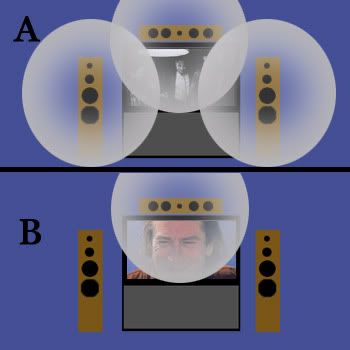I'm not sure that I have a specific answer to your question, but I thought it could be helpful to keep something things in mind: When you say that you have a problem with certain movies (and assumingly not with others), it might be the material.
Not all movies, nor music, nor TV Productions are created equal, and sometimes a reproduction system designed for accurate and/or pleasant playback needs some tweaking by the owner. When an engineer sits down to mix or remix a soundtrack to 5.1 for home viewing on a DVD, he or she faces many choices in terms of channel levels, equalization and dynamic range. No different than music remixes for SACD, each engineer has some creative decisions to make in terms of subtle use of channels or raucous, wild use. The point is, there is no standard in which to compare the end mix.
Just like many engineers mixing a music track will choose to "normalize" or heavily compress a track to sound louder, an engineer could choose to EQ a center channel of a DVD to offer what he considers to be a little more "intelligibility" in the dialog. Or change the panning (or soundstage).
Picture this: your visual is a medium shot of a room. When the actor is towards the back of the room, and you're watching him full-length, his voice is best represented with some energy from the center and some from your L and R speaker. (Illustration "A")
Now, the actor continues talking but walks right up to the camera position (getting right "in your face", so to speak). You would naturally assume that the sound from the L and R speakers will lessen, and the center speaker will now carry 100% of that actor's dialog. (Illustration "B").

So in the first scene, with all three speakers firing, the dialogue will seem to come from a point midway between all three speakers (assuming they are each getting the same "percentage" of that vocal in the soundtrack). And would essentially place the dialogue aurally as coming from the TV.
In scene B, however, with 100% of the sound coming from the center channel only, it can't help but sound as though the dialogue is coming from the center speaker itself 9because it is!) and will tend to make you feel like the dialogue is not coming from the TV. In other words, you are now easily "locating" the center channel and it is, in effect, calling attention to itself. It's not the fault of the speaker, nor receiver, but to a large degree the position of the speaker in that it's not dead-on with the TV screen. As a matter of fact, I think a better speaker that provides good imaging (for example a "point-source" design) would be much more prone to this than a "diffused" design.
I think the preference is to usually put the center above the TV rather than below with all things being equal. But two strong factors in placement will always be whether the most identifiable drivers (tweeters) are mostly in line with each other and how close you can get the center to the screen.
If the three front speakers are reasonably matched in tonality and volume the two variables left are positioning and the source material. Try a good selection of source material and if you're still not satisfied, try a different position for the speaker keeping the above in mind.
You could "soften" the response of the speaker a little in the treble with some EQ, but the crispness and clarity of dialogue might suffer a bit. And I don't know about you guys, but I seem to be finding more and more actors "mumbling" a bit to stay within "character". I guess it wouldn't be realistic for a doc in "E.R." to stop all the surrounding chaos to clearly enunciate "He's losing blood fast! Get me the Rapid Infuser!!".



